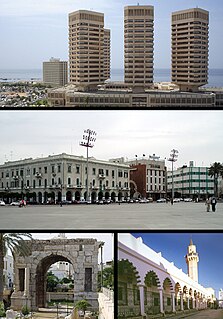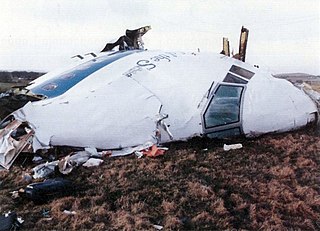
Tripoli is the capital city and the largest city of Libya, with a population of about 1.158 million people in 2018. It is located in the northwest of Libya on the edge of the desert, on a point of rocky land projecting into the Mediterranean Sea and forming a bay. It includes the port of Tripoli and the country's largest commercial and manufacturing centre. It is also the site of the University of Tripoli. The vast Bab al-Azizia barracks, which includes the former family estate of Muammar Gaddafi, is also located in the city. Colonel Gaddafi largely ruled the country, from his residence in this barracks.

Muammar Mohammed Abu Minyar Gaddafi, commonly known as Colonel Gaddafi, was a Libyan revolutionary, politician, and political theorist. He governed Libya as Revolutionary Chairman of the Libyan Arab Republic from 1969 to 1977, and then as the "Brotherly Leader" of the Great Socialist People's Libyan Arab Jamahiriya from 1977 to 2011. He was initially ideologically committed to Arab nationalism and Arab socialism but later ruled according to his own Third International Theory.

Cyrenaica is the eastern coastal region of Libya. Also known as Pentapolis in antiquity, it formed part of the Roman province of Crete and Cyrenaica, later divided into Libya Pentapolis and Libya Sicca. During the Islamic period, the area came to be known as Barqa, after the city of Barca.

Benghazi is the second-most populous city in Libya and the largest in Cyrenaica.
The Libya national football team is the national association football team of Libya and is controlled by the Libyan Football Federation. As of 2017, Libya has never qualified for the FIFA World Cup, the only team in North Africa that has failed to do so. The team has qualified for three Africa Cup of Nations: 1982, 2006, and 2012. In 1982, the team was both the host and runner-up. In the Arab Nations Cup, Libya finished second in 1964 and 2012, and third in the 1966.
Saif al-Islam Gaddafi is a Libyan political figure. He is the second son of the former Libyan leader Muammar Gaddafi and his second wife Safia Farkash. Gaddafi was awarded a PhD from the London School of Economics.

Muammar Gaddafi became the de facto leader of Libya on 1 September 1969 after leading a group of young Libyan military officers against King Idris I in a bloodless coup d'état. After the king had fled the country, the Libyan Revolutionary Command Council (RCC) headed by Gaddafi abolished the monarchy and the old constitution and established the Libyan Arab Republic, with the motto "freedom, socialism and unity".

Pan Am Flight 103 was a regularly scheduled Pan Am transatlantic flight from Frankfurt to Detroit via London and New York. On 21 December 1988, N739PA, the aircraft operating the transatlantic leg of the route was destroyed by a bomb, killing all 243 passengers and 16 crew – a disaster known as the Lockerbie bombing. Large sections of the aircraft crashed onto residential areas of Lockerbie, Scotland, killing 11 people on the ground. With a total of 270 people killed, it was the deadliest terror attack in the history of the United Kingdom.

The Chadian–Libyan conflict was a series of sporadic clashes in Chad between 1978 and 1987 between Libyan and Chadian forces. Libya had been involved in Chad's internal affairs prior to 1978 and before Muammar Gaddafi's rise to power in Libya in 1969, beginning with the extension of the Chadian Civil War to northern Chad in 1968. The conflict was marked by a series of four separate Libyan interventions in Chad, taking place in 1978, 1979, 1980–1981 and 1983–1987. In all of these occasions Gaddafi had the support of a number of factions participating in the civil war, while Libya's opponents found the support of the French government, which intervened militarily to save the Chadian government in 1978, 1983 and 1986.

The Libyan–Egyptian War was a short border war between Libya and Egypt in July 1977.

The Latin name Libya referred to the region west of the Nile generally corresponding to the Atlantic Mountains according to Diodorus. Its people were ancestors of the modern Libyan. They occupied the area for thousands of years before the beginning of human records in ancient Egypt. Climate changes affected the locations of the settlements.

Italian Libya was a colony of the Kingdom of Italy located in North Africa, in what is now modern Libya. Italian Libya was formed from the Italian colonies of Cyrenaica and Tripolitania that were taken by the Kingdom of Italy from the Ottoman Empire in 1911, during the Italo-Turkish War of 1911 to 1912. The unified colony was established in 1934 by governor Italo Balbo, with Tripoli as the capital.

The First Libyan Civil War, also referred to as the Libyan Revolution or 17 February Revolution, was an armed conflict in 2011 in the North African country of Libya fought between forces loyal to Colonel Muammar Gaddafi and those seeking to oust his government. The war was preceded by protests in Zawiya on 8 August 2009 and finally ignited by protests in Benghazi beginning on Tuesday, 15 February 2011, which led to clashes with security forces that fired on the crowd. The protests escalated into a rebellion that spread across the country, with the forces opposing Gaddafi establishing an interim governing body, the National Transitional Council.

The National Transitional Council of Libya, sometimes known as the Transitional National Council, was the de facto government of Libya for a period during and after the Libyan Civil War, in which rebel forces overthrew the Libyan Arab Jamahiriya of Muammar Gaddafi. The NTC governed Libya for a period of ten months after the end of the war, holding elections to a General National Congress on 7 July 2012, and handing power to the newly elected assembly on 8 August.

On 19 March 2011, a multi-state NATO-led coalition began a military intervention in Libya, ostensibly to implement United Nations Security Council Resolution 1973. The United Nations intent and voting was to have "an immediate ceasefire in Libya, including an end to the current attacks against civilians, which it said might constitute crimes against humanity ... imposing a ban on all flights in the country's airspace – a no-fly zone – and tightened sanctions on the Gaddafi regime and its supporters." The resolution was taken in response to events during the Libyan Civil War, and military operations began, with American and British naval forces firing over 110 Tomahawk cruise missiles, the French Air Force, British Royal Air Force, and Royal Canadian Air Force undertaking sorties across Libya and a naval blockade by Coalition forces. French jets launched air strikes against Libyan Army tanks and vehicles. The Libyan government response to the campaign was totally ineffectual, with Gaddafi's forces not managing to shoot down a single NATO plane despite the country possessing 30 heavy SAM batteries, 17 medium SAM batteries, 55 light SAM batteries, and 440–600 short-ranged air-defense guns. The official names for the interventions by the coalition members are Opération Harmattan by France; Operation Ellamy by the United Kingdom; Operation Mobile for the Canadian participation and Operation Odyssey Dawn for the United States. Italy initially opposed the intervention but then offered to take part in the operations on the condition that NATO took the leadership of the mission instead of individual countries. As this condition was later met, Italy shared its bases and intelligence with the allies.

The 2012 Benghazi attack was a coordinated attack against two United States government facilities in Benghazi, Libya by members of the Islamic militant group Ansar al-Sharia.

The Second Libyan Civil War is an ongoing conflict among rival factions seeking control of the territory and oil of Libya. The conflict at the beginning was mostly between the government of the House of Representatives (HoR) that was controversially elected in 2014, also known as the "Tobruk government"; and the rival General National Congress (GNC) endorsed government, also called the "National Salvation Government", based in the capital Tripoli, established after Operation Odyssey Dawn and the failed military coup.

The House of Representatives (HoR) is a legislature of Libya. As part of the ongoing Libyan Civil War, it represents the "Tobruk government" based in the east of the country.

The Libyan Crisis refers to the ongoing conflicts in Libya, beginning with the Arab Spring protests of 2011, which led to a civil war, foreign military intervention, and the ousting and death of Muammar Gaddafi. The civil war's aftermath and proliferation of armed groups led to violence and instability across the country, which erupted into renewed civil war in 2014. The ongoing crisis in Libya has so far resulted in tens of thousands of casualties since the onset of violence in early 2011. During both civil wars, the output of Libya's economically crucial oil industry collapsed to a small fraction of its usual level, with most facilities blockaded or damaged by rival groups, despite having the largest oil reserves of any African country. U.S. President Barack Obama stated on 11 April 2016 that not preparing for a post-Gaddafi Libya was probably the "worst mistake" of his presidency.
















